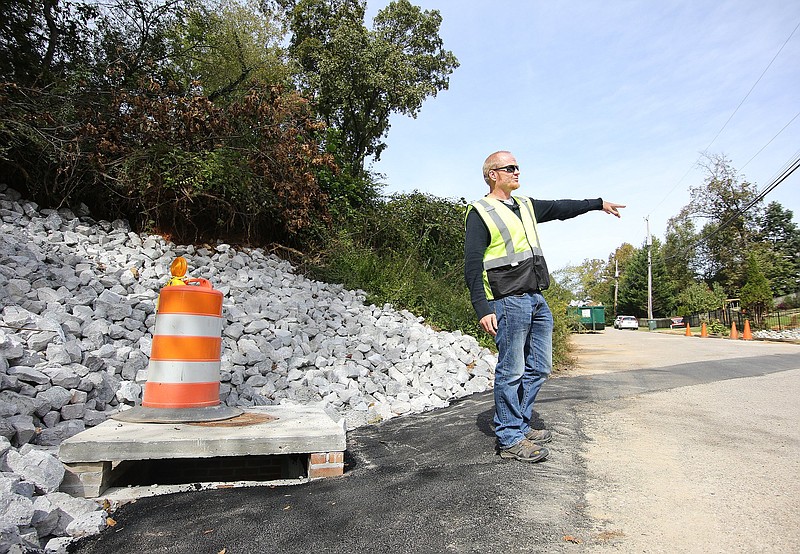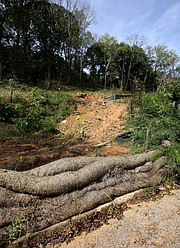A new set of proposed guidelines aimed at addressing overdevelopment of Chattanooga's most vulnerable land has been received with agreement from developers, but it's stirring new concerns among some residents who worry there will be little impact.
For several months, city staff have been researching and drafting measures that would lead to smarter development in neighborhoods where new homes and buildings on steep slopes and flood plains have created or exacerbated problems such as stormwater runoff and flooding in surrounding homes and neighborhood streets.
A temporary resolution announced by planning staff in November would allow grading or clearing on no more than 20 percent of any property where the slope is 33 percent or greater, would limit clearing and filling to 50 percent of a tract in a flood plain and it would require that where the site plan calls for a retaining wall, the wall must be built before the house or other structure is constructed.
But developers argued that those restrictions were too stiff and would damage the homebuilding industry, cost jobs and drive up the price of housing. At a city council meeting earlier this week, Councilman Darrin Ledford, the panel's chairman of planning and zoning, provided a new set of guidelines he said were created in collaboration with city staff and homebuilders in Chattanooga.
He said the new proposal addresses the three main concerns brought up in a public hearing of residents in October - stormwater runoff, erosion control measures and an aging infrastructure.
"Through this process, it is imperative that we identify comprehensively the reasonable and unreasonable and fortify the engagement of the public, stakeholders and our city staff," he said at the meeting.
Councilman Darrin Ledford' proposed guidelines:
Retaining wall requirements: Prior to obtaining a land disturbance permit, drawings for any retaining wall equal to or greater than four feet in height must be approved in advance. Any retaining walls to be constructed onsite shall be constructed prior to beginning construction of the habitual structure unless a waiver is issued by the city’s Land Development Office because of some unusual situation or scheduling issue. Erosion control construction documents: Sites which otherwise typically require an erosion control plan, or where located within a floodplain, shall be designed by a registered engineer and/or an individual who is in good standing with the Tennessee Department of Environment and Conservation having passed the necessary courses with a Level 2 certification. Such sites shall also provide a signed preparers statement stating the following: “I hereby certify that the plans prepared were done so with the understanding that this site has steep slopes/is located within a flood plain and that the erosion control measures indicated are designed to address these conditions.” Additional land development inspection prior to foundation inspection: Once a land disturbance permit is issued on a site with steep slopes, the foundation footing inspections by city personnel shall occur only once the onsite erosion control measures implemented are inspected and found to be in good standing.Additional peak flow stormwater requirements: Sites with 35 percent slopes requiring stormwater runoff attenuation through stormwater detention shall have the peak post-construction runoff rates for the 2, 5, 10 and 25-year storm events peak flows reduced by a minimum of 10 percent of the calculated pre-construction peak stormwater runoff rates. Additionally, sites filling in flood plain areas requiring stormwater runoff attenuation through stormwater detention shall have the peak post-construction runoff rates for the 2, 5, 10 and 25-year storm events peak flows reduced by a minimum of 10 percent of the calculated pre-construction peak stormwater runoff rates.
Later, Ledford told the Times Free Press he hopes to have the final language of the proposal cleared with the city attorney and council members can discuss it at their strategic planning session at 1:30 p.m. Tuesday.
The new standards would apply to single-family, residential subdivision, high-density residential, mixed-use, office, commercial and industrial developments, and they would be reviewed after a year to make sure they're a good fit for the community. Ledford said he didn't like the "copy and paste" language of the planning agency's initial temporary resolution that was based on guidelines in other cities.
Some of the new guidelines propose the following:
- Any retaining walls should be constructed prior to construction of the main building unless a waiver is issued from the Land Development Office.
- Sites that require an erosion control plan and are located within a flood plain should be designed by a registered engineer or an individual who is in good standing with the Tennessee Department of Environment and Conservation and have passed the necessary courses with a Level 2 certification.
- After a land disturbance permit is issued on a site with steep slopes, the foundation footing inspections by city personnel shall occur only once the onsite erosion control measures are inspected and found to be in good standing.
Jay Bell, president of the Homebuilder's Association of Greater Chattanooga, said he appreciates the city asking developers for their input for this new set of proposed rules.
"We just need to see how they work and make sure they achieve the objectives of the city," Bell said. "I think all rules need to be revised or reviewed periodically."
Heather DeGaetano has experienced firsthand the struggles of development on steep slopes and said Ledford's guidelines are a "watered down" version of the ones recommended by planning staff.
Living in North Chattanooga and near Knickerbocker Avenue, DeGaetano has seen development happen all around her over the last few years, which has caused many of the common problems, like stormwater runoff. She said that what used to be a 40 percent, wooded steep slope behind her house is now a leveled off hill with a large cement wall where building has been stalled for years.
"To me, the people who are affected by the impact of development on slopes should be there talking about it," she said. "Let's take what we think will work and make it better through research rather than ask the home developers what they want to do."
DeGaetano said it has been like an extra full-time job for residents the past few years to attend city council meetings and make sure their concerns are being heard. She is a page moderator for the Facebook group Chattanoogans for Responsible Development.
"Homebuilders don't have to deal with the consequences of it and that worries me," DeGaetano said. "The costs of dealing with erosion and runoff gets put on the city, and the city has little funding to handle it," adding that then the costs might be pushed onto taxpayers.
DeGaetano said she has extended an invitation to all council members to visit her neighborhood and see the effects of overdevelopment. So far, only Councilman Erskine Oglesby, who represents District 7 and the St. Elmo/Alton Park area, has taken her up on that offer.
The proposal's opposition from some residents adds to the deepening divide between residents, public officials and builders in the city over the matter. Chattanoogans for Responsible Development member Jim Johnson, who has a become a spokesman for locals wanting smart development, said he still needs to talk with councilman Ledford about his guidelines but his initial reaction is that anything would be better than what is currently in place.
"If this is short term and interim, I think it has the potential of being progressive and thoughtful on [Ledford's] part," Johnson said. "But if this is where we end up, I think we have a ways to go."
Johnson said he would like to advocate for a community meeting that doesn't have the time restrictions of an official city meeting or public hearing. The meeting would involve all the stakeholders, including public officials, developers, Realtors, residents and anyone else who wants a say in the issue.
In Johnson's opinion, there are a lot of residents who haven't given consideration to developer concerns, but there are also developers who haven't had to hear much of what the general public has to say.
"Something that is a challenge on so many fronts in the world of development of Chattanooga today is we jump too quickly to solutions and we don't spend enough time focusing on what it is we want to protect and promote," Johnson explained. "After we figure out that, we can look at what we want to potentially regulate or even prohibit."
Instead of having a civil conversation, Johnson asserts there has only been poor communication to this point.
"The way we are doing it now is frankly embarrassing," he added. "This just hasn't been done the Chattanooga way, and I think we have the opportunity to do this well and be an example to other cities."
Contact staff writer Allison Shirk Collins at ashirk@timesfreepress.com, @AllisonSCollins or 423-757-6651.

